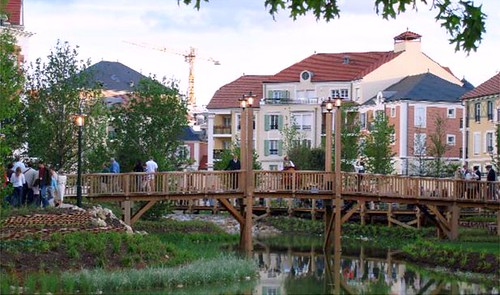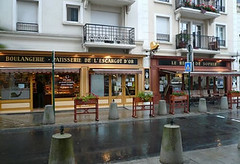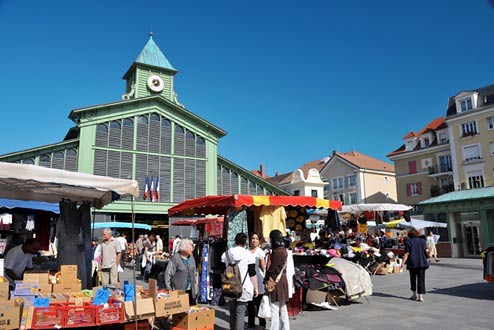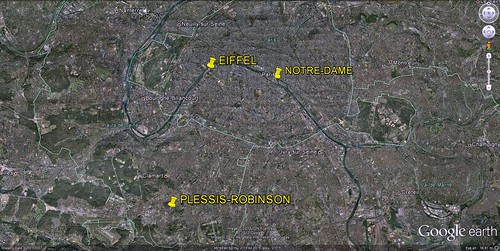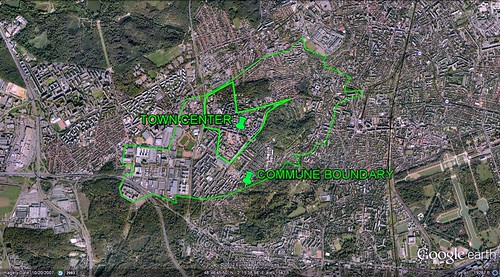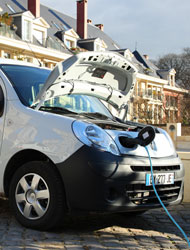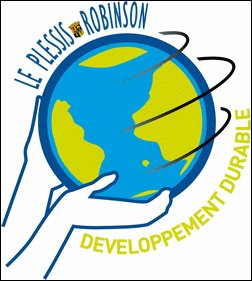Can US communities learn from this European suburban retrofit?

Posted February 22, 2012 at 1:49PM
In 2008, the substantially updated town center of Plessis-Robinson, a suburb of Paris, was named “the best urban neighborhood built in the last 25 years” by the European Architecture Foundation. A composite of six connected districts ranging in size from 5.6 to 59 acres, the revitalization comprises public buildings, retail, market-rate and subsidized affordable housing, parks, schools, gardens, sports facilities, and a hospital. Construction was begun in 1990 and took a decade to complete.
From the beginning, the concept was to develop a highly walkable environment, while using locally sourced materials as much as possible, and preserving wetland habitat. The town as a whole now contains seven parks and gardens amounting to over 120 acres of protected green space. (There are also three industrial and technology zones housing many of the town’s 240 companies and 11,000 employees.) Architecturally grounded in traditional French forms, the rebuilt sections look much as if they have been there for years.
The Eco Compact City Network, a European forum for municipalities, developers, architects, and other practitioners interested in green urbanism, describes the intention behind the transformation:
"The construction of the new urban centre is part of a particular town planning policy which the Municipality of Plessis-Robinson developed at the beginning of the 90s in order to start a virtuous process of transformation of a typical suburban settlement into a true urban environment. The project of [master planner] François Spoerry develops an attitude towards the creation of a hierarchy-oriented urban fabric in a regional style which strongly contributes to establish a clear identity in an suburban settlement which has chaotically grown up in the periphery of a large metropolis like the Franch capital.
"Being conceived as a model for future similar interventions of urban renaissance, the re-urbanisation plan has proven to be highly successful among the residents. While the reduced budget of [subsidized affordable] housing settlements did not allow the use of marble and stone, the extreme attention paid in the design process has led to a remarkable result of balance between the richness of details and the global coherence of the whole."
I first wrote about Plessis-Robinson back in 2008, after it had won top honors in the Phillipe Rotthier European Prize competition, selected by a jury of international architects and urbanists. I cited one of my fellow travelers in urbanist circles, Laurence Aurbach, who had previously written this about the project’s green features:
“Plessis-Robinson’s style of sustainability emphasizes parks and flowers, clean water, recycling, compact and walkable urban design, transit, nonpolluting vehicles, and green technical and administrative procedures for city government.”
The town is now not only significantly green but, as you can see, also immensely photogenic. American suburban communities currently contemplating transformative updates, such as Dublin, Ohio, parts of Prince George’s County, Maryland, and parts of Silicon Valley in California might do well to take note.
Under French law governing municipalities, Plessis-Robinson is a commune, sitting about 6.5 miles from the heart of Paris. In the satellite images, you see the town in relation to central Paris (with the centrally located Cathedral Notre Dame and Eiffel Tower marked for reference). And you see the area covered by the commune (about 1.3 square miles total), along with the more central revitalized portion. Its population was estimated at 26,581 in 2009.
Plessis-Robinson is served by bus transit and, about a mile from the center of town, the RER, the excellent regional rail system that serves Paris and its surroundings (there is a shuttle from P-R). Residents of the northeastern portion of the town are within comfortable walking distance to the rail station. Several new tram lines are also reportedly in the works.
Aurbach writes that, as of 1989 when a progressive mayor was elected (you see him in the video below), “three-quarters of the city’s residential stock was dilapidated public housing.” Some of the housing was renovated and some was demolished to make way for the new development, which continues to include affordable housing but now within a mixed-income, mixed-use community.
The town’s official website (in French) highlights its commitment to sustainable development, including walkable architecture, low-emission vehicles, water recycling, green space, a municipal tree registry, and accountability to the public.
There is reported history in the area now known as Plessis-Robinson dating as far back as 839, according to the town’s Wikipedia entry. The building that is now the Town Hall was built in the 17th century. Plessis was a popular weekend getaway for Parisians in the nineteenth century, and a more recent building boom took place after the turn of the 20th century.
Below is a terrific video showing the town’s progress. It’s in French but has great visuals and is highly informative even if you don’t speak the language. It looks like a great place to live:
Le Plessis-Robinson : Cœur de ville, l’école ANATOLE FRANCE (359) - kewego
Move your cursor over the images for credit information.
Please also visit NRDC’s Sustainable Communities Video Channel.
